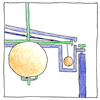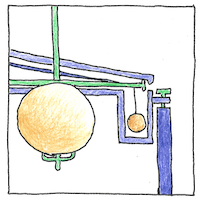John Michell, Henry Cavendish
geodesy

|
‘Weighing’ the world
Henry Cavendish measured the force of attraction between lead spheres using a torsion balance and compared that force to the weights of the spheres to calculate the specific gravity of the earth. The earth is 5.52 more dense than water; Cavendish got a value only 1.3% smaller than that, which is remarkable considering the extremely small forces he measured, roughly fifty one-millionth of the weight of the smaller of his lead spheres.
Torsion balance
Cavendish acquired the torsion balance of a man who invented it—geologist John Michell, who also conceived the experiment but died before beginning it. The torsion balance let Cavendish measure the force needed to twist a wire or fiber from which is hung a rotatable rod with spherical weights balanced at its ends. Cavendish built a wooden container for the balance to reduce the effects of heat or wind and measured his results using a pair of telescopes stuck through the wood focused on Vernier scales at the ends of the rod. However, even inside the container, this torsion balance was never at rest, but occillated with a period of about seven minutes; therefore, Cavendish had to measure the deflection due to the force of attraction as the balance swung back and forth.
Sequence of results
Given the weight and dimensions of the torsion balance, the oscillation-period of the balance rod, the distance between his rotating and his fixed spheres, the deflection of the torsion balance (with tenths read from the secondary scale), the weights of his spheres, the radius of the earth, one can solve a system of so many variables given so many independent relations between them. Otherwise, there is much we do not know.



Henry Cavendish is given credit for being the first to determine the density of the earth, from which one may derive the gravitational constant,
G, which we use to express Newton’s law today:F = G m1 m2 / r2where
Fis the force between two masses,m1andm2, separated by a distancer.John Michell was elected a fellow of the Royal Society in the same year as Cavendish, 1760. Cavendish rebuilt Michell’s torsion balance and conducted the experiment, but Michell was the scientist who realized that this device could measure the extremely small forces of attraction between objects smaller than mountains and, therefore, be used to determine the force of gravity. Cavendish’s lead spheres were two inches and twelve inches in diameter.
Michell’s genius was also shown in his work on magnetism, explaining the causes of earthquakes and tsumanis, and, in a letter to Cavendish that was not published until the 1970’s, explaining the effect of gravity on light and existence and nature of dark holes.
Cavendish is also known for the discovery of hydrogen, for his determination that the atmosphere is composed of one part oxygen and four parts nitrogen (leaving only 1/120th of volume for other gases), and numerous discoveries related to electricity that were not known until a century after he died. But Cavendish believed in phlogiston and his writings seem old-fashioned today; his experiments preceded the naming of the elements that he measured: hydrogen, oxygen, nitrogen, argon. Cavendish called hydrogen ‘inflammable air’ and he called oxygen ‘dephlogisticated air.’
See also in The book of science:
Readings in wikipedia:
Other reading: